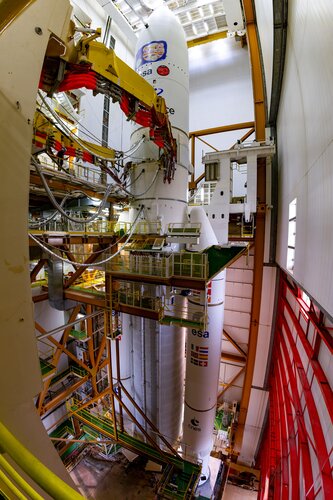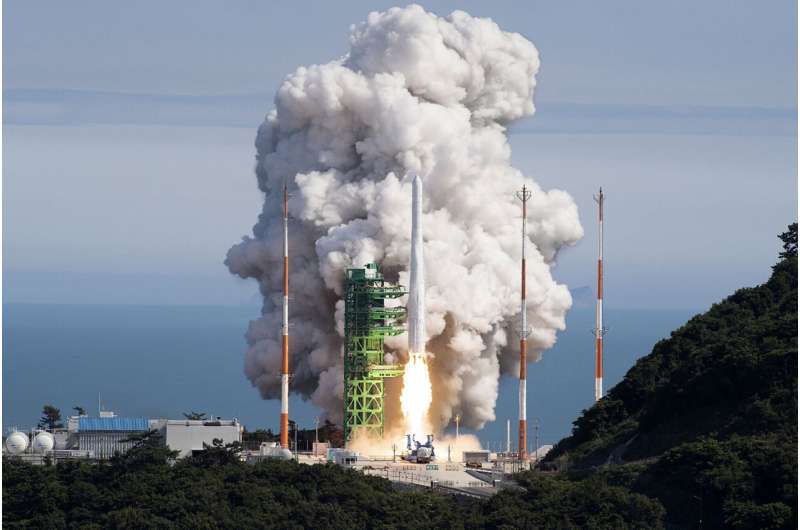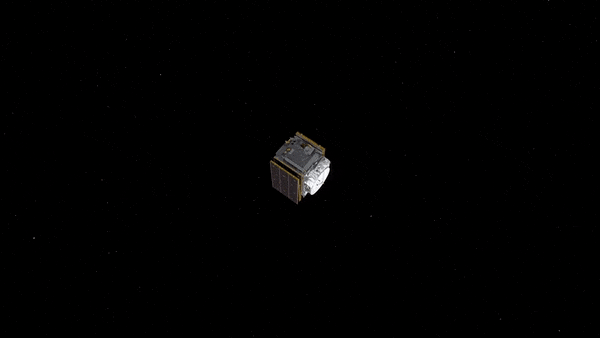
Copernical Team
Tuesday, 11 April 2023 10:25
Ariane 5 flight VA260, Juice: fully integrated and ready for rollout
 Image:
Ariane 5 flight VA260, Juice mission: fully integrated and ready for rollout at Europe's Spaceport in French Guiana
Image:
Ariane 5 flight VA260, Juice mission: fully integrated and ready for rollout at Europe's Spaceport in French Guiana
Published in
News
Tagged under
Tuesday, 11 April 2023 10:21
S Korea to conduct 1st launch of commercial-grade satellite

Published in
News
Tagged under
Tuesday, 11 April 2023 10:00
Juice: running on solar power in the dark

Welcome to Jupiter space: to one side looms the vast cloudy face of the largest planet in our Solar System; in the other appears a shrunken Sun, like a spotlight in the sky, with just 3% of the illumination from Earth orbit arriving here. This basic fact presented a major challenge to those planning ESA’s Jupiter Icy Moons Explorer, Juice, mission: how to make solar power work in such a gloomy environment, located an average 778 million km away from our parent star?
Published in
News
Tagged under
Tuesday, 11 April 2023 06:39
Beneath the Earth, ancient ocean floor likely surrounds the core
Tuscaloosa AL (SPX) Apr 10, 2023
 Through global-scale seismic imaging of Earth's interior, research led by The University of Alabama revealed a layer between the core and the mantle that is likely a dense, yet thin, sunk ocean floor, according to results published in Science Advances.
Seen only in isolated patches previously, the latest data suggests this layer of ancient ocean floor may cover the core-mantle boundary. Su
Through global-scale seismic imaging of Earth's interior, research led by The University of Alabama revealed a layer between the core and the mantle that is likely a dense, yet thin, sunk ocean floor, according to results published in Science Advances.
Seen only in isolated patches previously, the latest data suggests this layer of ancient ocean floor may cover the core-mantle boundary. Su
 Through global-scale seismic imaging of Earth's interior, research led by The University of Alabama revealed a layer between the core and the mantle that is likely a dense, yet thin, sunk ocean floor, according to results published in Science Advances.
Seen only in isolated patches previously, the latest data suggests this layer of ancient ocean floor may cover the core-mantle boundary. Su
Through global-scale seismic imaging of Earth's interior, research led by The University of Alabama revealed a layer between the core and the mantle that is likely a dense, yet thin, sunk ocean floor, according to results published in Science Advances.
Seen only in isolated patches previously, the latest data suggests this layer of ancient ocean floor may cover the core-mantle boundary. Su
Published in
News
Tagged under
Tuesday, 11 April 2023 06:39
Was plate tectonics occurring when life first formed on Earth?
Rochester UK (SPX) Apr 10, 2023
 Earth is a dynamic and constantly changing planet. From the formation of mountains and oceans to the eruption of volcanoes, the surface of our planet is in a constant state of flux. At the heart of these changes lies the powerful force of plate tectonics-the movements of Earth's crustal plates. This fundamental process has shaped the current topography of our pla
Earth is a dynamic and constantly changing planet. From the formation of mountains and oceans to the eruption of volcanoes, the surface of our planet is in a constant state of flux. At the heart of these changes lies the powerful force of plate tectonics-the movements of Earth's crustal plates. This fundamental process has shaped the current topography of our pla
 Earth is a dynamic and constantly changing planet. From the formation of mountains and oceans to the eruption of volcanoes, the surface of our planet is in a constant state of flux. At the heart of these changes lies the powerful force of plate tectonics-the movements of Earth's crustal plates. This fundamental process has shaped the current topography of our pla
Earth is a dynamic and constantly changing planet. From the formation of mountains and oceans to the eruption of volcanoes, the surface of our planet is in a constant state of flux. At the heart of these changes lies the powerful force of plate tectonics-the movements of Earth's crustal plates. This fundamental process has shaped the current topography of our pla
Published in
News
Tagged under
Tuesday, 11 April 2023 06:39
NASA awards agreement for high-resolution synthetic aperture radar
Greenbelt MD (SPX) Apr 11, 2023
 NASA has awarded a sole source Blanket Purchase Agreement (BPA) to Capella Space Corporation of San Francisco to provide high-resolution Synthetic Aperture Radar (SAR) (0.5 meter to 1.2 meters) commercial Earth observation data products.
Under this agreement, the government will issue fixed-price BPA Calls for these products, at a not-to exceed value of $7 million per Call. The work will b
NASA has awarded a sole source Blanket Purchase Agreement (BPA) to Capella Space Corporation of San Francisco to provide high-resolution Synthetic Aperture Radar (SAR) (0.5 meter to 1.2 meters) commercial Earth observation data products.
Under this agreement, the government will issue fixed-price BPA Calls for these products, at a not-to exceed value of $7 million per Call. The work will b
 NASA has awarded a sole source Blanket Purchase Agreement (BPA) to Capella Space Corporation of San Francisco to provide high-resolution Synthetic Aperture Radar (SAR) (0.5 meter to 1.2 meters) commercial Earth observation data products.
Under this agreement, the government will issue fixed-price BPA Calls for these products, at a not-to exceed value of $7 million per Call. The work will b
NASA has awarded a sole source Blanket Purchase Agreement (BPA) to Capella Space Corporation of San Francisco to provide high-resolution Synthetic Aperture Radar (SAR) (0.5 meter to 1.2 meters) commercial Earth observation data products.
Under this agreement, the government will issue fixed-price BPA Calls for these products, at a not-to exceed value of $7 million per Call. The work will b
Published in
News
Tagged under
Tuesday, 11 April 2023 02:43
Fish-inspired, self-charging electric battery may help power space applications
Niversity Park PA (SPX) Apr 11, 2023
 A research lab at Penn State will equally share a three-year, $2.55 million grant from the Air Force Office of Scientific Research (AFOSR) with three other teams at Carnegie Mellon University and the Adolphe Merkle Institute of the University of Fribourg in Switzerland. The multidisciplinary research collaboration aims to develop a framework for the design and production of soft, self-charging,
A research lab at Penn State will equally share a three-year, $2.55 million grant from the Air Force Office of Scientific Research (AFOSR) with three other teams at Carnegie Mellon University and the Adolphe Merkle Institute of the University of Fribourg in Switzerland. The multidisciplinary research collaboration aims to develop a framework for the design and production of soft, self-charging,
 A research lab at Penn State will equally share a three-year, $2.55 million grant from the Air Force Office of Scientific Research (AFOSR) with three other teams at Carnegie Mellon University and the Adolphe Merkle Institute of the University of Fribourg in Switzerland. The multidisciplinary research collaboration aims to develop a framework for the design and production of soft, self-charging,
A research lab at Penn State will equally share a three-year, $2.55 million grant from the Air Force Office of Scientific Research (AFOSR) with three other teams at Carnegie Mellon University and the Adolphe Merkle Institute of the University of Fribourg in Switzerland. The multidisciplinary research collaboration aims to develop a framework for the design and production of soft, self-charging,
Published in
News
Tagged under
Tuesday, 11 April 2023 02:43
Northrop Grumman expands space technology capabilities in Huntsville
Huntsville AL (SPX) Apr 11, 2023
 Northrop Grumman Corporation (NYSE: NOC) cut the ribbon on a new, two-building campus located just outside of Redstone Arsenal in Huntsville, Alabama, expanding its launch and missile defense development capability. This campus will be home to over 1,000 Northrop Grumman employees in the Huntsville area.
"Our new lab enables us to deliver innovative solutions to our customers on rapid time
Northrop Grumman Corporation (NYSE: NOC) cut the ribbon on a new, two-building campus located just outside of Redstone Arsenal in Huntsville, Alabama, expanding its launch and missile defense development capability. This campus will be home to over 1,000 Northrop Grumman employees in the Huntsville area.
"Our new lab enables us to deliver innovative solutions to our customers on rapid time
 Northrop Grumman Corporation (NYSE: NOC) cut the ribbon on a new, two-building campus located just outside of Redstone Arsenal in Huntsville, Alabama, expanding its launch and missile defense development capability. This campus will be home to over 1,000 Northrop Grumman employees in the Huntsville area.
"Our new lab enables us to deliver innovative solutions to our customers on rapid time
Northrop Grumman Corporation (NYSE: NOC) cut the ribbon on a new, two-building campus located just outside of Redstone Arsenal in Huntsville, Alabama, expanding its launch and missile defense development capability. This campus will be home to over 1,000 Northrop Grumman employees in the Huntsville area.
"Our new lab enables us to deliver innovative solutions to our customers on rapid time
Published in
News
Tagged under
Tuesday, 11 April 2023 02:43
Musk's Twitter marks BBC, NPR as 'government funded' but not Tesla or SpaceX
Washington DC (UPI) Apr 11, 2023
 Elon Musk's Twitter marked the BBC and NPR as "government-funded" on Saturday but has not applied the label to Tesla or SpaceX - which have received billions in subsidies.
Despite the significant contributions of federal and local governments to his businesses, Twitter this week decided to label NPR as "state-affiliated" media.
After pushback from NPR, Twitter has since changed the l
Elon Musk's Twitter marked the BBC and NPR as "government-funded" on Saturday but has not applied the label to Tesla or SpaceX - which have received billions in subsidies.
Despite the significant contributions of federal and local governments to his businesses, Twitter this week decided to label NPR as "state-affiliated" media.
After pushback from NPR, Twitter has since changed the l
 Elon Musk's Twitter marked the BBC and NPR as "government-funded" on Saturday but has not applied the label to Tesla or SpaceX - which have received billions in subsidies.
Despite the significant contributions of federal and local governments to his businesses, Twitter this week decided to label NPR as "state-affiliated" media.
After pushback from NPR, Twitter has since changed the l
Elon Musk's Twitter marked the BBC and NPR as "government-funded" on Saturday but has not applied the label to Tesla or SpaceX - which have received billions in subsidies.
Despite the significant contributions of federal and local governments to his businesses, Twitter this week decided to label NPR as "state-affiliated" media.
After pushback from NPR, Twitter has since changed the l
Published in
News
Tagged under
Tuesday, 11 April 2023 02:43
Rocket Lab updates launch location for NASA's TROPICS mission
Kennedy Space Center FL (SPX) Apr 11, 2023
 A NASA constellation of four storm tracking CubeSats are getting a new launch location as they prepare to study tropical cyclones beginning in the 2023 Atlantic hurricane season. NASA's Time-Resolved Observations of Precipitation Structure and Storm Intensity with a Constellation of SmallSats (TROPICS) will observe the atmosphere to increase our unders
A NASA constellation of four storm tracking CubeSats are getting a new launch location as they prepare to study tropical cyclones beginning in the 2023 Atlantic hurricane season. NASA's Time-Resolved Observations of Precipitation Structure and Storm Intensity with a Constellation of SmallSats (TROPICS) will observe the atmosphere to increase our unders
 A NASA constellation of four storm tracking CubeSats are getting a new launch location as they prepare to study tropical cyclones beginning in the 2023 Atlantic hurricane season. NASA's Time-Resolved Observations of Precipitation Structure and Storm Intensity with a Constellation of SmallSats (TROPICS) will observe the atmosphere to increase our unders
A NASA constellation of four storm tracking CubeSats are getting a new launch location as they prepare to study tropical cyclones beginning in the 2023 Atlantic hurricane season. NASA's Time-Resolved Observations of Precipitation Structure and Storm Intensity with a Constellation of SmallSats (TROPICS) will observe the atmosphere to increase our unders
Published in
News
Tagged under

